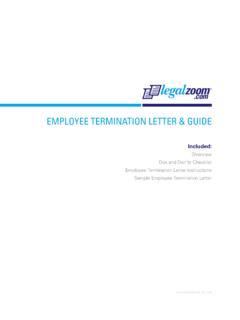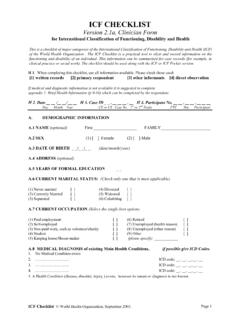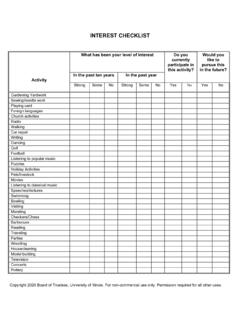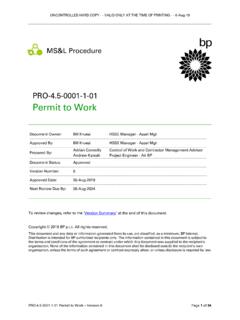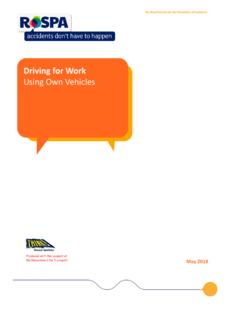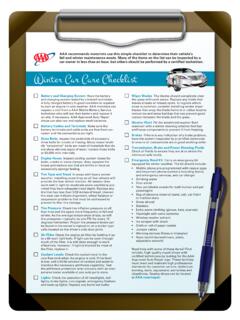Transcription of CELL PHONE USAGE POLICY & GUIDE
1 CELL PHONE USAGE POLICY & GUIDEI ncluded:Overview Dos and Don ts Checklist Cell PHONE USAGE POLICY Instructions Sample Cell PHONE USAGE POLICY , INC. 2008 1 CELL PHONE USAGE POLICY , INC. 2008 1. OverviewMobile phones, personal digital assistants, and other electronic innovations have given employers increased access to their employees, making those individuals more available and connected to their jobs. The business world understands that technologies have improved customer service and elevated employee efficiencies. However, companies are also starting to sense that these tools have also increased distractions and the potential exposure to corporate liability for employee acts. The temptation to make personal calls or access the internet on a PDA is hard to resist for even the most conscientious of employees, and these practices waste significant company money and time.
2 More seriously, as more laws are enacted governing the use of cell phones on the road, employers may find themselves accountable for their employees actions while driving . Establishing and enforcing a cell PHONE POLICY has thus become increasingly important, both to ensure employee performance and to shield companies from lawsuits and other liabilities. A well-crafted cell PHONE USAGE POLICY will not only set expectations for incoming employees, but will also address serious issues concerning the safety, security, and privacy of cell PHONE use. The enclosed document should prove useful to your business and, if you follow the suggestions provided, can provide the framework for a complete set of management policies. Your business will be able to draw on its technological resources without sacrificing either security or efficiency.
3 2. Dos & Don ts ChecklistCreating an employee cell PHONE USAGE POLICY is the first of many steps in establishing a healthy, professional, and dispute-free workplace. The following tips will provide additional guidance about protecting your employees and your company: A good cell PHONE USAGE POLICY should address current state laws about cell PHONE use while driving . Some states have passed laws prohibiting the use of handheld devices while operating a motor vehicle, while allowing the use of hands-free devices. Review your state s laws and local ordinances to make sure that the POLICY you draft is in line with regulations in your area. Be reasonable in your policies. Modern employees work long hours, leaving their houses before dawn and returning well into the night. For the sake of workplace morale and staff retention, you should allow some cell PHONE communication between employees and their family members.
4 The enclosed POLICY includes a provision governing camera phones, which present an increasing risk to companies. Intellectual property, trade secrets, personal customer information, or other confidential data can be captured and used easily with a camera PHONE . Employees may have their picture taken in private areas, and may be able to sue your company for invasion of privacy or harassment. Having a POLICY in place is only the first step. The POLICY must be enforced and your employees must understand the consequences of failing to abide by its terms. 2 CELL PHONE USAGE POLICY , INC. 2008 Every person employed by your company should review and sign your POLICY . This includes new, old, temporary, and permanent employees, managers, supervisors, full-time professionals, part-time staff, independent contractors, and freelancers.
5 Allow your employees ample time to review and sign the POLICY . This will reduce the likelihood, or at least the efficacy, of a claim that an individual did not understand the POLICY s terms. Review the cell PHONE USAGE POLICY carefully. One size may not fit can use these suggestions and the enclosed sample to create a thorough cell PHONE USAGE POLICY , a POLICY that will protect your company from both internal and external risks. You will have created a document that can be used with each new employee, and that may protect your company and its employees from unnecessary personal and professional risks. 3. Cell PHONE USAGE POLICY InstructionsThe following provision-by-provision instructions will help you understand the terms of your cell PHONE USAGE POLICY . Please review the entire POLICY before starting the step-by-step process.
6 Introduction. Explains the general purpose of the POLICY . Cell phones are defined broadly in the introduction, and include most handheld devices. If there are other items that you would like to add to the list, feel free to include those here. Section 1: Use of Cell Phones or Similar Devices. Details company policies about the use of personal cell phones in the office or on other company property ( , construction sites, manufacturing areas, stores, etc.). Section 1(a): General Use at work . Provides that personal cell phones being used for personal calls should be used sparingly in the workplace. Section 1(b): Unsafe work Situations. Requires that in unsafe work situations ( , construction sites, near heavy machinery, etc.), cell phones (whether personal or business-issued) not be used. Section 1(c): Use While driving .
7 Includes an absolute ban on employee use of cell phones, whether personal or Company-issued, while driving on Company-related business. Section 2: Personal Use of Company-Owned Cell Phones. Governs the use of cell phones that were provided to an employee by the company, and indicates more specifically that these phones are for business use only. This section also notes that any such cell phones are to be protected by the employee, and returned when his or her employment ends. Section 3: Company-Owned and Supplied Devices or Vehicles. Prohibits the use of cell phones while driving , both when those phones are company-issued and when the vehicle is PHONE USAGE POLICY , INC. 2008 Section 4: No Use of Camera Phones. Camera phones can present risks to a company, potentially compromising customer information, trade secrets, or the privacy of other employees.
8 The risks posed vary from industry to industry, and company to company, and you should add or delete requirements based on your specific needs. If you are unwilling to prohibit camera phones entirely from your premises, consider designating certain areas where those phones are banned ( , restrooms, locker rooms, laboratories, manufacturing areas, etc.). You may also want to include information in the POLICY about your state s video voyeurism law, if any. These laws prohibit the recording or disseminating of images of an individual s private areas without consent, when the recording was made in a location that the person expected would be private. Add a list of potential penalties and indicate that you will refer all instances of video voyeurism to the proper authorities. Section 5: Review of Monthly Charges.
9 Allows the Company to monitor USAGE of phones that it has issued to employees and allows an employee s manager to determine the consequences of excessive or irregular use. Section 6: Special Responsibilities of Managerial Staff. This final section emphasizes the importance of management providing a good example of cell PHONE use, and in guarding against excessive or inappropriate use of such phones by their company that uses the tools provided in this package can clarify an employee s obligations and duties regarding cell PHONE use. This knowledge and awareness can increase efficiencies and protect your is not a law firm. The information contained in the packet is general legal information and should not be construed as legal advice to be applied to any specific factual situation. The use of the materials in this packet does not create or constitute an attorney-client relationship between the user of this form and LegalZoom, its employees or any other person associated with LegalZoom.
10 Because the law differs in each legal jurisdiction and may be interpreted or applied differently depending on your location or situation, you should not rely upon the materials provided in this packet without first consulting an attorney with respect to your specific materials in this packet are provided "As-Is," without warranty or condition of any kind whatsoever. LegalZoom does not warrant the materials' quality, accuracy, timeliness, completeness, merchantability or fitness for use or purpose. To the maximum extent provided by law, LegalZoom, it agents and officers shall not be liable for any damages whatsoever (including compensatory, special, direct, incidental, indirect, consequential, punitive or any other damages) arising out of the use or the inability to use the materials provided in this PHONE USAGE POLICY , INC.




